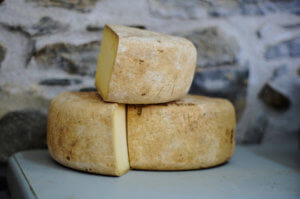
Cheese has comprised some diets around the world for a long time. It’s invention has allowed milk to be preserved longer and has found it’s way into numerous modern kitchens. But what is it exactly that causes the milk to turn into cheese? Well, it is mold, along with bacteria and other microorganisms that create this dairy product…
Yes, that’s right. “In a lot of ways, cheese is mold”, says Cheese Operations Manager at Di Bruno Bros. Philadelphia’s O.G. cheese shop, Rich Morillo. With the notable exception of fresh cheeses, such as mozzarella and ricotta, which are meant to be consumed shortly after creation, most others owe what gives them their flavor to the reaction that occurs when the mold, bacteria and other microorganisms feast on the proteins and sugar present in milk. The blue stuff in Stilton? Mold. The white rind on the outside of Brie? Yep – “a whole lot of fuzzy white mold”, Morillo says. It is worth noting, however, that those with compromised immune systems, pregnant women, young children and the elderly should best avoid eating these cheeses.
A little more on these cheeses before we continue:
- Originating from the village of Camembert and named by Napoleon himself after tasting it for the very first time in 1855, the first ever batch was made with pasteurized cow’s milk, which was then curdled and introduced to bacteria to encourage the production of mold. The cheese starts off soft and crumbly but gets creamier within two to three weeks, by which point it should have acquired a yellow appearance!
- Produced in only eight dairies across the United Kingdom, strict guidelines must always be followed, including ensuring it is made with local pasteurized milk, remains unpressed, takes on the traditional cylindrical shape in its final form, has blue veins radiating from the center and forms its own crust.
- Originating from Milan in Italy, Gorgonzola is made from pasteurized cow’s milk and added with the bacteria Lactobacillus bulgaricus, Streptococcus thermophilus and Penicillium glaucum mold spores, before being aged at low temperatures for three to four months and inserted with metallic rods to help create air pockets for the growth of mold.
Babysitting Cheese?
In fact, in many ways the job of a cheesemaker and cheesemonger is, what Morillo describes, “babysitting and letting nature do its work.” He says that whilst it’s rare to find mold on cheese that would actually present a health concern, it doesn’t mean you should eat it – distinguishing the optimal levels achieved during the cheesemaking process to attain flavor and texture perfection from the later-onset mold that grows on the chunk of cheddar that’s been forgotten about at the back of your fridge.
So, what should you do with the unplanned mold that has made itself very much at home on an otherwise perfect slab of cheese? Unlike mold on bread, most people agree that you can cut off the affected part (at least 1 inch around and below the mold) and continue to enjoy the rest, but this does, of course, depend on the cheese. Mold will have a hard time penetrating harder cheeses, such as cheddar or parmesan, but will certainly manage to get deep into the roots of wetter cheeses, such as mozzarella and ricotta. Not only will it affect the flavor and texture of the cheese, it can also harbor other harmful bacteria such as listeria, salmonella and E. coli, so best to toss it. Whilst heating mold will kill it, it won’t kill the toxins produced by the mold, which is why the FDA does not recommend doing so!
According to food scientist and spokeswoman for the Institute of Food Technologists, Kantha Shelke, however, “mold on some cheeses such as Danish Blue, Brie, and Camembert and in cheeses like Gorgonzola, Stilton, and Roquefort contribute to their flavor and are safe to consume,” before adding that it’s “better to be safe than sorry when it comes to moldy foods and cheeses.”
What do you think? Get discussing below!
Read more about mold that grows on food here.
from Mold Blogger https://moldblogger.com/say-cheese/
Mold Remediation Baltimore
No comments:
Post a Comment